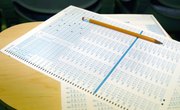The ACT exam (not to be mistaken for the SAT test) is a standardized test that is used for college admissions in the United States. This test covers four main academic skill areas: mathematics, english, reading comprehension, and science (with an optional writing test as well). ACT test scores do not impact your gpa, but it is still worthwhile to do some necessary act prep beforehand so you are ready for your test date. After all, the better the prep, the better the test-taker.
This test may seem like the next terrifying step for a high school student, but you should be excited, not scared. By studying well beforehand and learning a number of ACT test-taking strategies, you should have no problem earning a high ACT score. And remember, you can always retake the ACT, but this will come at additional charges you could otherwise avoid if you do well on your first try.
Tip
Not finishing your test does affect your ACT score. In the ACT, you gain points by answering questions correctly. By not finishing, you miss the points you might have gained from those questions.
Do Wrong Answers Count Against You on the ACT?
In the test itself, remember to answer every question. You won’t lose points for incorrect answers. You have probably already heard something like, “There is no penalty for guessing on the ACT.” What does this mean? Well, in other tests, guessing an answer incorrectly can deduct points from your overall score. The way the ACT is scored, each question you answer correctly will add points to your score. Questions you answered incorrectly will neither add points nor deduct them. In other words, there is no guessing penalty if you are stuck on a question; ACT scores are accumulated only by getting correct answers.
Don’t Get Stuck on Difficult Questions
You only have a limited time to answer each question, and the clock is ticking. If you reach a question and you just can’t work it out, mark that question and move on to the next one. Once you work your way to the end of the test, if you still have time, go back to the questions that you skipped. Even if you can’t figure out these questions in the end, never leave them blank. Choose one letter to use for your guess questions. That way, if you answer each guess question with the letter C, the odds are in your favor that a certain fraction of them will be right.
Make Educated Guesses
Make answering easier by ranking the answers in the multiple choice question. Many questions have at least one or two answers that don’t make sense. Cross these answers out. Now, you are choosing from only two possible correct answers, and you are much more likely to get the answer right.
Wait to Bubble in Your Answers
Budget your test-taking time so that you have a few minutes to bubble in your answer sheet at the end. Flipping back and forth between your bubble sheet and your test booklet wastes more time than you might think. The entire test takes 175 minutes, allocating less than a minute to answer each question. Use your time wisely and shave off any extra time you would spend fumbling with papers.
Practice Your Timing
Since time is so important for the ACT, it is vital that you practice under testing conditions. This means that when you take practice tests, only give yourself the amount of time you would have for the actual ACT. You can also time how long it takes to answer each question. If a certain type of question takes you longer to answer, you may need to practice that type of question until you can do it more quickly.
Tips for the English Section of the ACT
One of the trickiest parts of the ACT English section is the questions that ask you to spot errors in sentences. The problem is that when you read them, they almost always sound correct. However, there are several common types of errors that you can memorize before the test. These errors include subject-verb agreement, word-use confusion and errors in syntax, like dangling modifiers. To practice for this section, do exercises that ask you to utilize your editing skills. Also, try to use good grammar and spelling in your daily correspondence. (Yes, that means you should text in complete sentences with proper punctuation.)
ACT Strategies: English Section Tips
Read the Questions and Answers First
Before you tackle reading the passages, read the questions and answers first. Don’t use this as an excuse to skim the reading, though. Read the paragraphs completely before you choose an answer. Knowing what the answers are beforehand will give your active reading skills an edge.
Go With the Simplest Correct Choice
If more than one answer seems to correctly complete the sentence, go with the simplest choice. The ACT is trying to promote clear, readable writing. A significant percentage of your answers – as many as 30 percent of them – may be “no change.” Although you are probably wary of choosing that answer because it seems like the tricky “all of the above” or “none of the above” you have seen in the past, keep in mind that the simplest correct sentence may require “no change.”
Tips for the Math Section of the ACT
You can write on the test booklet, so use that extra space to work out questions. You can also create sketches to help you visualize more complex problems. Only do this if you really need to, as venturing too far into doodling can waste precious time you will need for this section.
ACT Strategies: Math Section Tips
Memorize Formulas
Unlike the SAT, the ACT test will not provide a sheet of formulas for you to use for working out problems. This means that you will have to memorize these formulas. Make flashcards that match formulas to the particular type of math question they work out. As you memorize the formulas, start taking practice tests where you don’t allow yourself any outside help from formula sheets. This will replicate the conditions you will experience on test day.
Use Diagrams to Eliminate Answers
While the diagrams given may not be perfect representations of the questions, you can use the diagrams to eliminate certain answers from multiple-choice questions. For example, you can use your knowledge of angles to identify obtuse, acute and right angles. If the question is asking you to measure angle A, and the diagram shows angle A is acute, you know that any answer above 89° is incorrect.
Check Your Answers by Working Backward
Plug your answers into the formula in the question to see if they work. This works especially well for algebra or questions that use a graph. If you plot your answers on the graph and they do not land on the appropriate line, you have chosen the incorrect answer, and you need to rework the problem.
Tips for the Reading Section of the ACT
Just like in the English section, be sure to read carefully and look for the simplest, sensible answer. Read the questions and answers before you begin the passage, but don’t use this as an excuse for lazy reading. Read the passage thoroughly and underline sections that seem important, especially places where you think you might find an answer. Come back to those places when you’re answering the questions. It is also helpful to jot notes in the margins. For every passage, write what you think its main idea is. Underline the sentence that clued you in.
ACT Strategies: Reading Section Tips
Don’t Skim the Passages
It is tempting to try to read too quickly. Don’t read too fast, but don’t read too slowly either. Read actively and for comprehension, writing notes and underlining important details. When you skim, you miss things. Those things might just be the answers. Practicing active reading and writing limited notes saves time because you won’t have to go back and read passages multiple times.
You Don’t Have to Go in Order
There are four different types of passages you will encounter in the ACT: narratives, science articles, humanities articles and social science articles. Start by reading the ones you think will be easiest for you. For example, if science is not your strength, you might consider starting with a narrative. This way, you will quickly answer several easy questions, leaving yourself time to tackle more difficult passages.
Tips for the Science Section of the ACT
The science section of the ACT is also reading-heavy. For this reason, you will benefit from using the same reading strategies as you did in the reading section. Read questions and answers first, and then read the passage carefully, underlining and taking notes where appropriate. Avoid skimming, as that can lead to wasting time rereading and sloppy answers.
In these passages, the focus tends to be on the relationships, reasoning, data and trends. The difficulty in these passages lies in their extraneous details. You won’t need to know everything in the passages to answer your questions. That is why reading the questions beforehand will help streamline your process.
ACT Strategies: Science Section Tips
Don’t Ignore the Pictures
Many questions in the ACT science section will be illustrated by a graph or diagram. These visual representations are often key to understanding complex concepts in passages. They can also be the secret to finding answers quickly. Knowing how to read and interpret graphs and data sets is a bigger part of the ACT science section than it seems. So, practice interpreting these visuals as much as you practice your reading skills. However, don’t be tempted to skip the reading entirely and look only at the graphs. This is sloppy test taking and may cause you to interpret the graph incorrectly and choose the wrong answer.
Skip Conflicting Viewpoints and Come Back to Them Later
The conflicting viewpoints section requires a great deal of reading and logical interpretation, and therefore it can end up wasting a lot of your test time if you’re not careful. Knowing the potential time cost of this section can help you plan your strategy. Try to answer all other parts of the science section before you try to take on this one. With that strategy, you can devote time to a larger number of questions.
Tips for the Writing Section of the ACT
This section is optional, but you should plan to take it anyway because it is required by some colleges. You don’t want to limit where you can apply just because you didn’t want to write an essay.
During the writing portion of the ACT, you will be expected to write a standard five-paragraph essay, which will be graded on organization, logic, elaboration, grammar and overall writing quality. Your essay absolutely must have an introduction and conclusion. Essays of fewer than four paragraphs will not score full points.
ACT Strategies: Writing Section Tips
Memorize Quotations and Examples
To achieve the rhetorical sophistication necessary for a high score on the ACT writing section, you will need to use examples and outside quotations to back up your reasoning. This means that you will have to memorize them. Choose an example that can apply to many different writing prompts. Examples from history or literature tend to resonate with a wide audience. You will be able to get a lot of use out of a quotation from Abraham Lincoln, Nelson Mandela or another equally important historical figure. Choose a few examples and quotations to memorize, and treat these with the same level of importance as you do the formulas you are memorizing for math.
Outline Your Essay
Create an outline for your essay, but don’t waste too much time doing so. A simple thought map will work just fine. If there are certain aspects of a great essay that you tend to forget to use, write notes to remind yourself to include them.
Be Thorough
Don’t forget to budget a little time to go back and read your essay. You may catch simple mistakes that would have otherwise brought down the overall quality of your writing.
Related Articles
References
Writer Bio
Rebecca Renner is a teacher and college professor from Florida. She loves teaching about literature, and she writes about books for Book Riot, Real Simple, Electric Literature and more.










